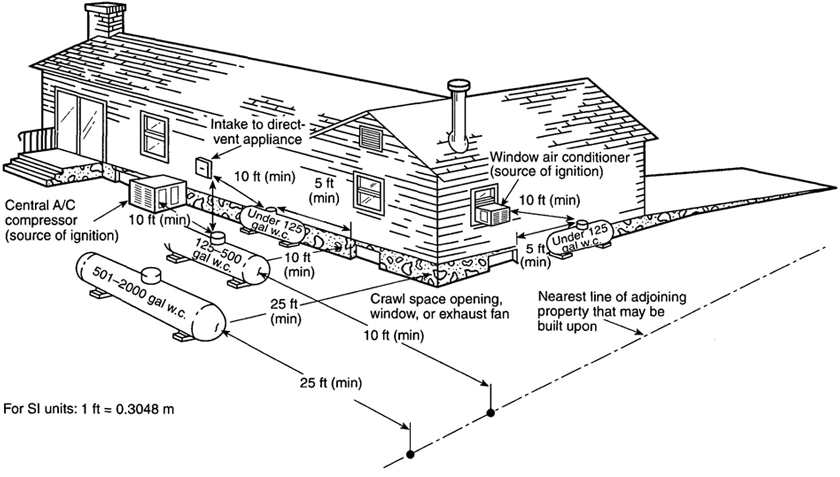Above-Ground Propane Tank Installation
Acceptable locations for propane tank installation are largely determined by safety considerations. Local, State, and Federal propane safety codes specify minimum distances between propane tanks/connections and structures such as homes, outbuildings, driveways, septic systems, parking lots, playgrounds, property lines, other propane tanks, etc. These minimum distances are balanced by maximum distances from the driveway, as the propane truck hoses can only reach so far. Federal regulations also prohibit filling your tank from a propane delivery vehicle parked on the side of any government maintained road.
Texas Best Propane service technicians are trained to know these and other specifications. We will be happy to work with you to select a location for your propane tank that is convenient, safe, and adheres to propane safety regulations.
Propane Tank Distance Requirements
One of the most visited subjects in the propane industry is distance requirements for propane tanks. Distance rules are applicable to propane tanks and their connections in relation to what surrounds them, whether it's a house or another propane tank. Care and consideration of surrounding buildings, driveways, awnings, house or building openings, property lines and more need to be taken into account when placing a propane tank in a legal and safe location.
Container Distance Requirements
The distance requirements for propane tank locations are dependent upon the container size. Generally, the majority of tanks fall under a ten foot rule with regard to buildings and houses. The standards and rules differ when locations such as playgrounds, parking lots, railroad tracks or other flammable materials are taken into consideration. Propane companies and professionals will ensure propane tank distance requirements are adhered to when installing a propane tank in any location. The graphic below depicts common residential container distances required by the NFPA.

Point of Transfer Distance Requirements
The point of transfer is defined as "the location where connections and disconnections are are made or where LP-Gas is vented to the atmosphere in the course of transfer operations". The transfer of propane during the filling process results in residual liquid release between the tank fill valve and the hose end connection upon completion of transfer. When the hose is unhooked from the tank, liquid is released into the atmosphere. For this reason, the point of transfer is subject to distance requirements.
Relief Valve Distances
Safety relief valves are subject to distance rules for the simple fact that if the relief valve opens allowing propane to vent, the vicinity above and around the relief valve needs to be clear of obstructions and ignition sources. A safety relief valve on an ASME propane tank, if fully activated, will vent propane vertically up and for this reason, propane tanks have to be installed out from under an awning or part of a building overhang.
Underground Propane Tank Installation
Underground propane tanks are exposed to unique environmental conditions and have distinct regulations and standards regarding their installation and maintenance. Underground propane tanks are designed and manufactured with specialized features that allow them to safely store propane underground for years. Obviously, propane tanks manufactured for above ground use cannot be installed underground.
The location of underground propane tanks should be carefully thought out. Like above-ground propane tanks, they should be situated an adequate distance from your home and outbuildings. Underground propane tanks should not be in a location that is near or underneath any sort of vehicular traffic.

Here at Texas Best Propane, we are careful to observe safety regulations for installation and inspection of underground propane tanks. Our propane service professionals strive to provide the absolute best service so that your underground propane tank is properly installed and inspected prior to use.
Underground Propane Tank Protection
Underground propane tanks are exposed to hostile conditions that can shorten their service life. Texas' Best Propane uses special precautionary and protective measures to safeguard your underground propane tank.
Underground propane tanks are usually in contact with moisture and are therefore subject to rust formation. Manufacturers apply a protective coating to the external surface of underground propane tanks to discourage the development of rust. We take great care to safeguard the underground propane tanks' protective coating during and after installation. We utilize backfill that is free of sharp rocks and abrasive materials to cover our underground propane tanks.
The earth contains natural electromagnetic currents that can create a phenomenon known as electrolysis, which is erosion of the steel molecules of the underground propane tank. Over time, electrolysis can erode enough steel molecules to threaten the integrity of the underground propane tank. This can lead to propane tank failure and dangerous gas leaks.
We employ several methods to protect our customers' underground propane tanks from the dangerous effects of electrolysis. First, we wire 'sacrificial anode bags' of magnesium to each underground propane tank. We place these sacrificial anode bags adjacent to our customers' propane tanks before the propane tank is covered up with backfill. The sacrificial anode bags act as a decoy and absorb the earth's adjacent electromagnetic currents that would have otherwise targeted the propane tank.
One of the most unnerving sights a propane customer can witness is their newly-installed underground propane tank floating in the hole in which it was recently buried. To prevent floating, underground propane tanks are either secured in place with ground anchors and metal straps the feet are embedded into wet concrete that is poured into the hole just prior to lowering the propane tank into the hole.
